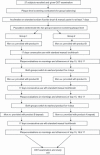Can anti-erosion dentifrices also provide effective plaque control?
- PMID: 21356021
- PMCID: PMC3170713
- DOI: 10.1111/j.1601-5037.2010.00480.x
Can anti-erosion dentifrices also provide effective plaque control?
Abstract
Objective: While gingivitis and caries continue to be prevalent issues, there is growing concern about dental erosion induced by dietary acids. An oral hygiene product that protects against all these conditions would be beneficial. This study investigated the potential of two anti-erosion dentifrices to inhibit plaque.
Methods: This was a randomized, three-period, two-treatment, double-blind, crossover study evaluating a stannous chloride/sodium fluoride dentifrice (SnCl(2)/NaF, blend-a-med(®) Pro Expert) and a popular anti-erosion dentifrice (NaF, Sensodyne(®) ProNamel(™)). During Period 3, subjects were randomized to repeat one treatment to evaluate any product carryover effects. Each treatment period was 17 days. Test dentifrices were used with a standard manual toothbrush. Digital plaque image analysis (DPIA) was employed at the end of each period to evaluate plaque levels (i) overnight (am prebrush); (ii) post-brushing with the test product (am post-brush); and (iii) mid-afternoon (pm). Analysis was conducted via an objective computer algorithm, which calculated total area of visible plaque.
Results: Twenty-seven subjects completed the study. At all time points, subjects had statistically significantly (P ≤ 0.0001) lower plaque levels after using the SnCl(2)/NaF dentifrice than the NaF dentifrice. The antiplaque benefit for the SnCl(2)/NaF dentifrice versus the NaF dentifrice was: am prebrush = 26.0%; am post-brushing = 27.9%; pm = 25.7%.
Conclusions: The SnCl(2)/NaF dentifrice provided significantly greater daytime and overnight plaque inhibition than the NaF toothpaste. When recommending dentifrice to patients susceptible to dental erosion, clinicians can consider one that also inhibits plaque.
© 2010 John Wiley & Sons A/S.
Similar articles
-
What is the effect of active ingredients in dentifrice on inhibiting the regrowth of overnight plaque? A systematic review.Int J Dent Hyg. 2020 May;18(2):128-141. doi: 10.1111/idh.12423. Epub 2019 Dec 22. Int J Dent Hyg. 2020. PMID: 31675470 Free PMC article.
-
A randomized clinical trial to compare plaque inhibition of a sodium fluoride/potassium nitrate dentifrice versus a stabilized stannous fluoride/sodium hexametaphosphate dentifrice.J Contemp Dent Pract. 2009 Mar 1;10(2):1-9. J Contemp Dent Pract. 2009. PMID: 19279966 Clinical Trial.
-
Randomized in vivo trial evaluating plaque inhibition benefits of an advanced stannous-containing sodium fluoride dentifrice used in conjunction with power brush technology.Int J Dent Hyg. 2014 May;12(2):89-95. doi: 10.1111/idh.12040. Epub 2013 Jul 12. Int J Dent Hyg. 2014. PMID: 23844867 Free PMC article. Clinical Trial.
-
A randomized clinical study comparing the plaque inhibition effect of a SnF2/SHMP dentifrice (blend-a-med EXPERT GUMS PROTECTION) and a chlorhexidine digluconate dentifrice (Lacalut Aktiv).J Clin Dent. 2009;20(2):33-8. J Clin Dent. 2009. PMID: 19591334 Clinical Trial.
-
Stabilized stannous fluoride dentifrice in relation to dental caries, dental erosion and dentin hypersensitivity: A systematic review.Am J Dent. 2020 Apr;33(2):95-105. Am J Dent. 2020. PMID: 32259415
Cited by
-
Antibacterial Action, Substantivity and Anti-plaque Effect of Different Toothpaste Slurries - A Randomised Controlled Trial.Oral Health Prev Dent. 2021 Oct 22;19:529-536. doi: 10.3290/j.ohpd.b2182977. Oral Health Prev Dent. 2021. PMID: 34673844 Free PMC article. Clinical Trial.
-
Stannous Source in Toothpastes Leads to Differences in Their Antimicrobial Efficacy.Oral Health Prev Dent. 2023 Sep 22;21:319-324. doi: 10.3290/j.ohpd.b4424911. Oral Health Prev Dent. 2023. PMID: 37737308 Free PMC article.
-
The Effect of Extrinsic Factors on the Mechanical Behavior and Structure of Elastic Dental Ligatures and Chains.Polymers (Basel). 2021 Dec 23;14(1):38. doi: 10.3390/polym14010038. Polymers (Basel). 2021. PMID: 35012064 Free PMC article.
-
What is the effect of active ingredients in dentifrice on inhibiting the regrowth of overnight plaque? A systematic review.Int J Dent Hyg. 2020 May;18(2):128-141. doi: 10.1111/idh.12423. Epub 2019 Dec 22. Int J Dent Hyg. 2020. PMID: 31675470 Free PMC article.
-
DenTiUS Plaque, a Web-Based Application for the Quantification of Bacterial Plaque: Development and Usability Study.J Med Internet Res. 2020 Sep 3;22(9):e18570. doi: 10.2196/18570. J Med Internet Res. 2020. PMID: 32663148 Free PMC article.
References
-
- Lewis KJ, Smith BGN. The relationship of erosion and attrition in extensive tooth tissue loss. Br Dent J. 1973;135:400–404. - PubMed
-
- Shaw L. Dental erosion in a group of British 14-year-old school children Part II: influence of dietary intake. Br Dent J. 2001;190:258–261. - PubMed
-
- Nunn JH, Gordon PH, Morris AJ, Pine CM, Walker A. Dental erosion – Changing prevalence? A review of British national childrens’ surveys. Int J Paediatr Dent. 2003;13:98–105. - PubMed
-
- Jaeggi T, Lussi A. Prevalence, incidence and distribution of erosion. Monogr Oral Sci. 2006;20:44–65. - PubMed
Publication types
MeSH terms
Substances
LinkOut - more resources
Full Text Sources


